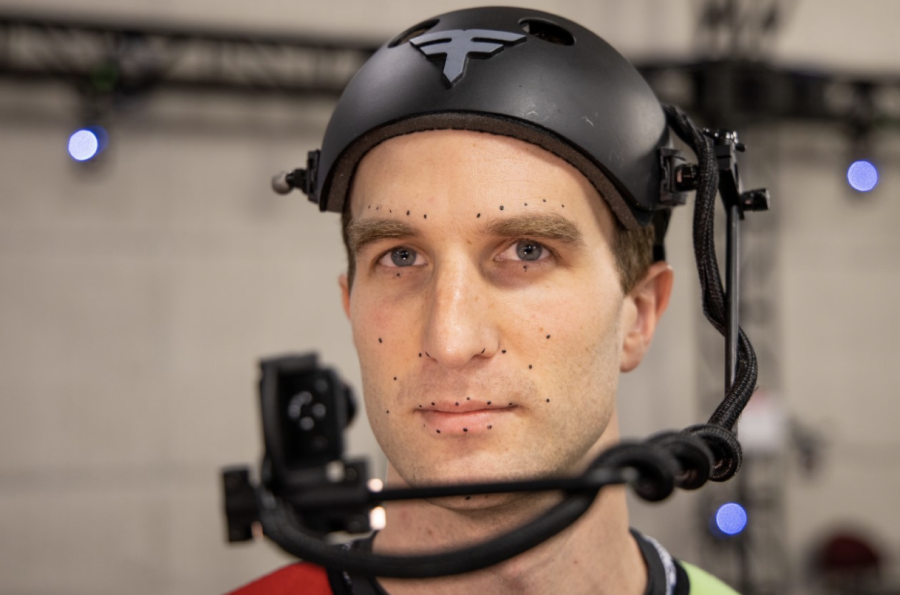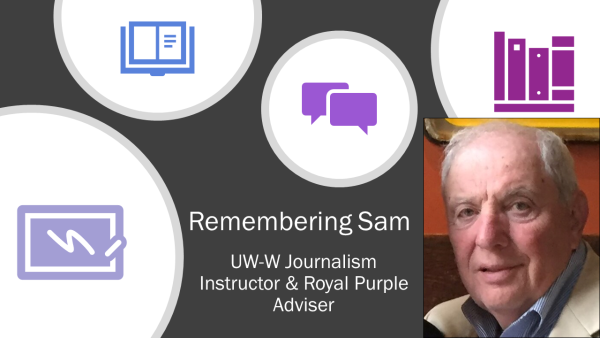UWW Alumni lights up the big screen
Alumni Tyler King demonstrates a newly designed facial capture helmet with Faceware Tech.
November 6, 2022
Motion Capture has been an active agent in our media since the 1970’s. recording the movement of objects or people. It has become so crucial to the way our shows and games are produced, that it can be hard to imagine that Whitewwater and the world of Motion Capture have a common thread. UW-Whitewater Alumni, Tyler King, serves as that connection. Originally from Jefferson, WI, King attended the University of Wisconsin-Whitewater from 2006-2010 where he received a BFA in Theatre Performance as well as a Dance Minor. Though he now resides in Los Angeles, King speaks fondly of his time at UWW. The Royal Purple sat down with the score to speak about his time in university and his current career.
Q: When were you first introduced to the world of Motion Capture?
I think it was my junior year we did a production of MacBeth and I was McDuff. We brought in a really great choreographer named Jeff. Jeff was a guy that worked over at Raven Software in Madison, which is owned by Activision. They do a lot of Motion Capture for video games. So I worked with him on the McDuff/MacBeth sword fight, and he was like you know we got something coming up that I’d like you to come in to run through. It was cool of course because it would later come back. All I do now is Motion Capture for video games and movies.
Q: Were there specific classes or moments from UWW that now contribute to your work?
MacBeth was a big one just because I met Jeff there. The dance department in general was a big one because you just learn how to move on stage a lot better and a lot more naturally when you’re much more aware of your own body and how to carry yourself. Or how a character would carry themselves. But also the professors there at the time. Angela Iannone taught Laban Movement technique, and that was huge for me as well. Learning Laban was just another tool that I was able to use for character work. I still use that.
Q: A lot of people don’t know what goes into Motion Capture. Can you describe the practice in your own words?
I mean it’s exactly what it sounds like; but at the same time, people say ‘what does that mean?’ We get into these suits that are like the soft-side of Velcro. It’s about as tight as a wet suit. Then we get markers put on us that have reflective tape on them, and there are anywhere from like 20 to 120 cameras pointed at us from all different directions. The cameras aren’t normal video cameras. They’re cameras that shine – I think it’s usually a red light. It’s a light that picks up the reflective markers. Because of all the markers on us we basically get digitized in a sense. I don’t understand all the computer side of things of course. But essentially the computer software then figures out what the skeleton would look like based on the markers that we have on.
Q: Has there been a favorite project you have worked on?
I think the one that I’m working on right now checks that box. But because we have to sign all these NDA‘s, we’re not allowed to say what it is. I think before that, one that just came out recently that I was really happy to work on was the Last of Us: Part 1 remake. I knew about that one right when I was getting into Motion Capture; and I always viewed it as if I could work on a game like that, then I’ll really have made some headway. Cut to six years later, and I actually worked on the game.
Q: You’ve stated that you recently tried to start voice acting. How is that going?
Actually, I just signed with a voiceover agent in the last three weeks. Fortunately the people I was working with on the video game I can’t mention, they helped me put a demo reel together and introduced me to the right people.
Q: If we see a person completing an impossible stunt in a video game or movie, how much of the action is being performed by the Motion Capture actor?
It depends on the motion that is happening. So if a character has to start on the ground, jump 30 feet in the air, and then a flip to land back down. What we can do in Motion Capture is get me into doing a little bend down and jumping up, and then will have that part of the motion. We’ll then get me a flip, so we’ll have that part. Then they’ll get me doing some kind of cool landing with a pose that they want. What the animators can then do is their magic. We’re giving them the poses, the flipping motion, starting motion, and landing motion. They can then go in and end up doing what they want.
Q: To a UWW student trying to pursue a career in acting, whether in Motion Capture or not, what advice would you give them?
Just to keep pursuing their other hobbies and other interests that’s outside of acting. If they’re already going to school for acting, that’s going to take care of itself. The thing that makes people unique in this industry is those seemingly random skills that people pick up throughout their life.













